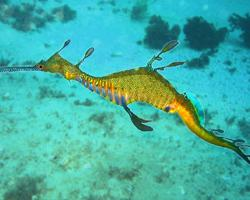
Statut de conservation
| Menacé |
Description de l'animal
The Common Seadragon (Phyllopteryx taeniolatus) is a captivating marine creature that belongs to the family Syngnathidae, which also includes seahorses and pipefish. This species is primarily found along the southern and western coasts of Australia, thriving in the temperate waters that provide an ideal habitat for its survival and proliferation. The common seadragon is a true marvel of the ocean, showcasing a unique blend of camouflage, morphology, and reproductive behavior that distinguishes it from other marine species.One of the most striking features of the Common Seadragon is its extraordinary appearance, designed by nature to blend seamlessly with its surroundings. This creature possesses a long, slender body that can grow up to 45 centimeters in length, adorned with leaf-like appendages that protrude from its body. These appendages, resembling the seaweed and kelp among which it dwells, serve as an effective camouflage, protecting the seadragon from predators while also allowing it to ambush prey. The body of the Common Seadragon is a canvas of vibrant colors, with hues ranging from yellow to orange, and patterns that mimic the light filtering through the water onto the seafloor.
The diet of the Common Seadragon mainly consists of tiny crustaceans, plankton, and larval fish, which it sucks into its long, pipe-like snout with a quick snap. Unlike most fish, seadragons do not have teeth or a stomach; food is directly absorbed through their digestive tract. This unique feeding mechanism requires them to eat almost constantly to sustain their energy levels.
Another fascinating aspect of the Common Seadragon is its reproductive behavior, particularly the role of the male in the process. In a remarkable reversal of traditional roles found in most animal species, it is the male seadragon that carries and nurtures the eggs until they hatch. The female deposits up to 250 eggs onto a specialized brood patch located on the underside of the male's tail. The eggs are then fertilized and embedded into the brood patch, which supplies them with oxygen. For about eight weeks, the male carries the eggs, protecting them until they hatch, at which point he releases the fully formed, miniature seadragons into the water.
Despite its mesmerizing beauty and fascinating biology, the Common Seadragon faces threats from habitat loss, pollution, and the impacts of climate change. These factors, along with its limited range and the curiosity it sparks in collectors and underwater tourists, have led to concerns about its population stability. Conservation efforts are underway to protect the habitats of the Common Seadragon and ensure that this extraordinary species can continue to thrive in the wild. Measures include marine protected areas, restrictions on collecting and handling, and research to better understand the needs and vulnerabilities of this species.
In conclusion, the Common Seadragon (Phyllopteryx taeniolatus) is a remarkable example of nature's ingenuity, showcasing not only the beauty and diversity of marine life but also the intricate adaptations that have evolved over millions of years. Its unique appearance, intriguing behaviors, and the challenges it faces remind us of the importance of marine conservation and the need to protect the delicate ecosystems that harbor such incredible creatures.
Nouvelles photos d'animaux
Top 10 des animaux
- Common reed warbler (Acrocephalus scirpaceus)
- Diana monkey (Cercopithecus diana)
- Moustached guenon (Cercopithecus cephus)
- Galápagos tortoise (Geochelone nigra complex)
- Dolphin gull (Leucophaeus scoresbii)
- Hen harrier (Circus cyaneus)
- Brant (Branta bernicla)
- Stone loach (Barbatula barbatula)
- Common house mosquito (Culex pipiens)
- Colossal squid (Mesonychoteuthis hamiltoni)